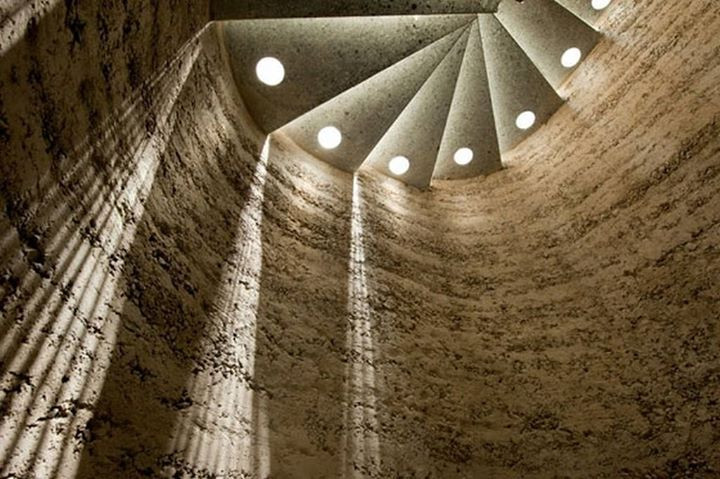Martin Rauch
For this year’s summer months, we have prepared an exhibition that explores a subject that remains topical today: the use of earth in contemporary architecture. The exhibition presents one of the most respected personalities on today’s European scene, Martin Rauch, who has spent many years working with clay and earth architecture.
The use of earth as a building material is as old as the history of mankind. And yet this material is perhaps more contemporary than any other, thanks to its physical and structural characteristics as well as its environmental nature.
Martin Rauch and his company Lehm Ton Erde have been developing new techniques and realizing projects using stamped clay for 30 years. Important aspects of this process include constant improvements in construction techniques, the expansion of the material’s possibilities, and also the combination of contemporary architecture with aesthetics. Working with renowned foreign artists and architectural studios such as Theo Lüthi, Roger Boltshauser, Herzog & de Meuron, Marte Marte, Olafur Eliasson, and Simon Starling, Rauch has created works of architecture and installations that have influenced this technology both in technical as well as creative ways.
Lehm – Ton – Erde. These three words describe the activities of Martin Rauch, but they also have a symbolic meaning and capture his comprehensive philosophy: LEHM (Loam) stands for handcraft and technology, TON (Clay) for artistic design, and ERDE (Earth) for the environmental sustainability of buildings made of earth.
Martin Rauch was born in 1958 in Schlins, a town in the Austrian province of Vorarlberg. In 1978–83, he studied ceramics under professors Matteo Thun and Maria Bilger-Perz at Vienna’s University of Applied Arts. He has been engaged in the design, planning, and realization of earth construction at home and abroad since 1984, and in 1999 he founded the company Lehm Ton Erde, Baukunst GmbH. Rauch has had numerous solo and group exhibitions, among other places in Feldkirch, Meran, Paris, Graz, and Venice. His many awards include the 2008 Fassa Bortolo International Prize for Sustainable Architecture, the 2008 Builders’ Award of the Austrian Association of Architects, and the 2011 Holcim Award – School for Sustainable Development in Morocco. He has led numerous international workshops in places as diverse as Bangladesh, South Africa, and Austria in collaboration with BASEhabitat. Since 2010, he has been UNESCO Honorary Professor in the Chair of Earthen Architecture and since 2014 he has been a guest lecturer at ETH Zurich’s department of architecture.
The exhibition – Martin Rauch’s first in the Czech Republic – has been designed especially for the spaces of the České Budějovice House of Art. It offers a look at “refined earth” and also includes works created directly in České Budějovice over the course of a few days during the exhibition’s installation as part of workshops for students of architecture working under Rauch’s guidance.
“Rauch discovered clay architecture not through architecture, but through his education and his first projects as a ceramicist, oven builder and sculptor. His tendency towards applied craftsmanship, towards the thoroughly artistic autonomy of living and environmental design, was already predetermined by his family’s farming roots in Vorarlberg, although the decisive impulses for Rauch came to him abroad in that like some of his older siblings he worked for many months as an aid volunteer in Africa. The encounter with ‘primitive’ means of existence and techniques of building in simple cycles and with the optimal use of resources occurred simultaneously to observing their brutal displacement by technologies from the First World that were extremely complex, ecologically far worse, difficult to repair, and non-recyclable.
In Africa his artistic impulse took on a global perspective. His subjective tendency to work with povera – primitive artistic material – found an objective, conceptual framework. The shaping of clay grew to a desire to architecturally design with earth. The molding of tiles and ovens became shaping and construction on a larger scale in the recasting of soil into inhabitable (spatial) figures. Instead of handing in the tea service called for by Matteo Thun for his diploma project at the University of Applied Arts Vienna, Rauch submitted a study on the potential of clay construction.
From the beginning onwards his interest was particularly focused on stamped-clay techniques, a method by which the material is not subject to any additional facing or enhancement. As in the case of unfired or low-fired unglazed ceramics, the fabrication of un-stuccoed pisé constructions (such as those Rauch also came across amongst anonymous outbuildings in France) led abruptly to an expression of itself. The layered erection of the wall simultaneously weaves the ornament of its own appearance. The pure structure, color and haptics of the material remain unaltered and intensively preserved in the process of forming and compression. With the sensitivity of the ceramicist for the composition and the physical-chemical conditions and effects of his material, Rauch set about to rearticulate the language of clay as a building material, to exhaust all the facets of the earthen material, whereby technical advances and enhancements went hand-in-hand with formal complexity. Step-by-step he experimented with and improved the natural mixture of materials, the compression techniques, the shape of the formwork, and developed the old techniques further using additional layers of reinforcement, but without departing from their structural frameworks. Tools, frame forms, working techniques were developed a new, test walls erected, and the experiences gathered in the single-handed execution of the structures put to immediate use in each subsequent series of tests.” (Otto Kapfinger)
